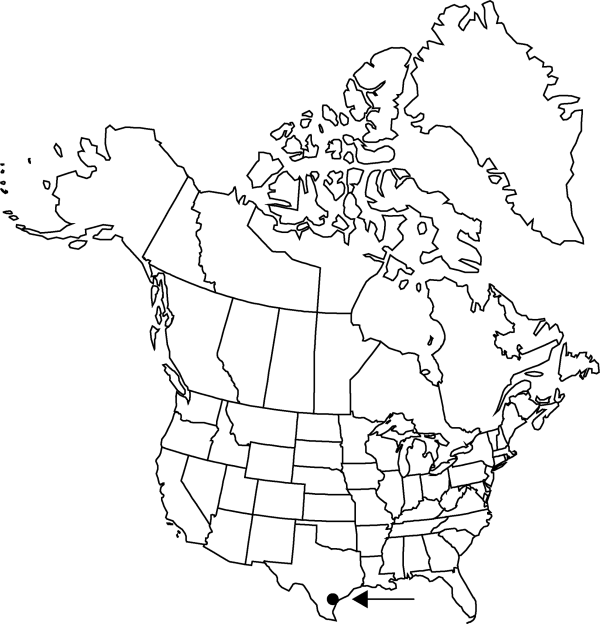Difference between revisions of "Boerhavia ciliata"
Univ. Calif. Publ. Bot. 4: 270. 1912.
FNA>Volume Importer |
FNA>Volume Importer |
||
| Line 19: | Line 19: | ||
}}<!-- | }}<!-- | ||
| − | --><span class="statement" id="st- | + | --><span class="statement" id="st-undefined" data-properties=""><b>Herbs,</b> perennial, slightly woody at base; taproot long, ropelike, ± woody. <b>Stems</b> decumbent to ascending, sparingly branched throughout, 2–7 dm, with minute, crinkled hairs and spreading long hairs, sometimes also glandular basally, glabrous distally. <b>Leaves</b> mostly in basal 1/2 of plant; larger leaves with petiole 2–24 mm, blade ovate to orbiculate, occasionally wider than long, 10–25 × 6–22 mm (distal leaves smaller, proportionately narrower), adaxial surface glabrate to sparsely pilose, especially on veins, abaxial surface much paler than adaxial, glabrous or moderately pilose, especially on veins, neither surface punctate, base round to cordate, margins entire or sinuate, apex obtuse to round. <b>Inflorescences</b> axillary or terminal, forked ca. 2–4 times unequally, open, without sticky internodal bands; branches ascending-divergent, terminating in loose, 1–3-flowered, cymose clusters. <b>Flowers</b>: pedicel 1–6 mm; bracts at base of perianth persistent, usually 3, linear to lanceolate, 1–1.5 mm; perianth pale pink to pink, occasionally purple-red, widely funnelform distal to constriction, 2.5–3 mm; stamens 3–5, well exserted. <b>Fruits</b> borne singly (2–3 in open clusters), gray-brown, oblong-clavate, 2.8–3.2 × 1.3 mm (l/w: 2.3–2.7), apex broadly conic to round, glabrous; ribs 5, round or very bluntly angled, smooth or rugose near sulci, edges sharp and slightly overhanging sulcus; sulci to 1/2 times as wide as base of ribs, not rugose, minutely papillate. <b>2n</b> = ca. 52.</span><!-- |
-->{{Treatment/Body | -->{{Treatment/Body | ||
| + | |phenology=Flowering late spring-mid fall. | ||
|habitat=Open limestone and caliche in brush, arid grasslands | |habitat=Open limestone and caliche in brush, arid grasslands | ||
|elevation=0-100[-2000] m | |elevation=0-100[-2000] m | ||
| Line 40: | Line 41: | ||
|basionyms= | |basionyms= | ||
|family=Nyctaginaceae | |family=Nyctaginaceae | ||
| + | |phenology=Flowering late spring-mid fall. | ||
|habitat=Open limestone and caliche in brush, arid grasslands | |habitat=Open limestone and caliche in brush, arid grasslands | ||
|elevation=0-100[-2000] m | |elevation=0-100[-2000] m | ||
| Line 47: | Line 49: | ||
|publication year=1912 | |publication year=1912 | ||
|special status= | |special status= | ||
| − | |source xml=https://jpend@bitbucket.org/aafc-mbb/fna- | + | |source xml=https://jpend@bitbucket.org/aafc-mbb/fna-data-curation.git/src/9216fc802291cd3df363fd52122300479582ede7/coarse_grained_fna_xml/V4/V4_30.xml |
|genus=Boerhavia | |genus=Boerhavia | ||
|species=Boerhavia ciliata | |species=Boerhavia ciliata | ||
| − | |||
| − | |||
| − | |||
| − | |||
| − | |||
| − | |||
| − | |||
| − | |||
| − | |||
| − | |||
| − | |||
| − | |||
| − | |||
| − | |||
| − | |||
| − | |||
| − | |||
| − | |||
| − | |||
| − | |||
| − | |||
| − | |||
| − | |||
| − | |||
| − | |||
| − | |||
| − | |||
| − | |||
| − | |||
| − | |||
| − | |||
| − | |||
| − | |||
| − | |||
| − | |||
| − | |||
| − | |||
| − | |||
| − | |||
| − | |||
| − | |||
| − | |||
| − | |||
| − | |||
| − | |||
| − | |||
| − | |||
| − | |||
| − | |||
| − | |||
| − | |||
| − | |||
| − | |||
}}<!-- | }}<!-- | ||
-->[[Category:Treatment]][[Category:Boerhavia]] | -->[[Category:Treatment]][[Category:Boerhavia]] | ||
Revision as of 15:04, 27 July 2019
Herbs, perennial, slightly woody at base; taproot long, ropelike, ± woody. Stems decumbent to ascending, sparingly branched throughout, 2–7 dm, with minute, crinkled hairs and spreading long hairs, sometimes also glandular basally, glabrous distally. Leaves mostly in basal 1/2 of plant; larger leaves with petiole 2–24 mm, blade ovate to orbiculate, occasionally wider than long, 10–25 × 6–22 mm (distal leaves smaller, proportionately narrower), adaxial surface glabrate to sparsely pilose, especially on veins, abaxial surface much paler than adaxial, glabrous or moderately pilose, especially on veins, neither surface punctate, base round to cordate, margins entire or sinuate, apex obtuse to round. Inflorescences axillary or terminal, forked ca. 2–4 times unequally, open, without sticky internodal bands; branches ascending-divergent, terminating in loose, 1–3-flowered, cymose clusters. Flowers: pedicel 1–6 mm; bracts at base of perianth persistent, usually 3, linear to lanceolate, 1–1.5 mm; perianth pale pink to pink, occasionally purple-red, widely funnelform distal to constriction, 2.5–3 mm; stamens 3–5, well exserted. Fruits borne singly (2–3 in open clusters), gray-brown, oblong-clavate, 2.8–3.2 × 1.3 mm (l/w: 2.3–2.7), apex broadly conic to round, glabrous; ribs 5, round or very bluntly angled, smooth or rugose near sulci, edges sharp and slightly overhanging sulcus; sulci to 1/2 times as wide as base of ribs, not rugose, minutely papillate. 2n = ca. 52.
Phenology: Flowering late spring-mid fall.
Habitat: Open limestone and caliche in brush, arid grasslands
Elevation: 0-100[-2000] m
Distribution

Tex., Mexico (San Luis Potosí, Tamaulipas).
Discussion
Selected References
None.